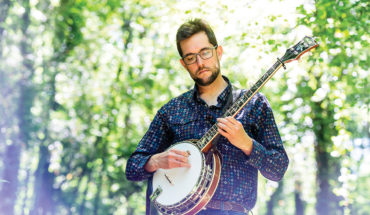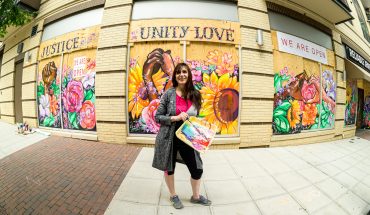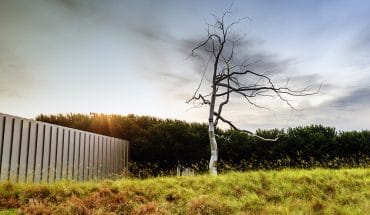The plywood murals throughout downtown are more than art—they’re symbols for a social movement.
by Colony Little / Photography by Gus Samarco
This summer, downtown Raleigh buildings were awash in a sea of color.
The artistic expressions were as diverse as the artists who created them. Portraits placed in conversation with text-based works mingled with punchy graphics and wildstyle graffiti. Quiet memorials communed with thought-provoking quotes. A dimensional floral installation contrasted with bold paint strokes and the softer touch of sidewalk chalk. The murals that bloomed throughout the city captured the spirit and energy of a movement.
Though the plywood murals became a living art exhibit, their origins were fraught: through May and June, following the killing of George Floyd in Minneapolis, North Carolina residents took to the streets in Black Lives Matter marches. The first peaceful protest was eclipsed by a group of vandals that damaged storefronts of businesses surrounding Fayetteville Street, many of which had just reopened after the onset of the coronavirus. The next morning, cleanup efforts brought the community together, patching broken windows with plywood.
And in the wake of the destruction, these barricades became blank canvases, platforms for artists to share memorials, manifestos and calls to action.
At the Zen Succulent, artist Katelyn Richelle worked closely with business owner Megan G. Cain to tie together the store’s operations with a protest refrain evolved from a poem by Dinos Christianopoulos: They tried to bury us, they didn’t know we were seeds. Brilliant cacti pop against a marigold background—but under the ground, the names of unarmed Black people killed in recent years are written on just-as-brilliant seeds, a hopeful gesture of healing, resilience and renewal. The dichotomy is intentional: “I have a lot of rage, and the broken windows reflect more of my current emotions than the paint on the boards,” says Richelle. “I hope that people see the agony, trauma and hurt underneath the beauty.”
Artist Dare Coulter transformed Raleigh Raw’s entrance with a reimagined preamble to the Constitution: We the People are in Peril. Her text-driven piece incorporates a quote from writer Audre Lorde, messages affirming the business’s support of Black lives and a protestor carrying a sign that asks, What Side of History Will You Be On? The words are intentionally provocative. “It’s not about what’s comfortable and what feels good,” says Coulter, “it’s about what needs to be said.”
An early pair of murals painted by artists Joe Giampino (known as SPCLGST) and Nick Osetek at City Market were commissioned by owner/chef Jeff Seizer of Royale. In theirs, bold letters proclaim Love and Light and Black Lives Matter in oversize letters. The murals force us to reckon with the realities of our present. “They encourage us to use our voices and urge us to move forward toward progress,” says Seizer.

Artist Johvone “Vone” Smith paints outside of City Market Barber & Style Shop, basing his mural around the words “Love” and “Unity”
Seizer later worked with the Raleigh Murals Project and VAE Raleigh to raise funds for additional murals through an effort called the Public Art Response. With guidance from an ad hoc advisory committee of arts leaders from Anchorlight Black Project and Raleigh Arts Council representatives, the Public Art Response connected artists and building owners to bring 25 more murals to life throughout downtown and Glenwood Avenue, with still more commissioned independently.
Jedediah Grant of the Raleigh Murals Project underscores that their initiative was not designed to be a beautification effort, but an opportunity to amplify the voices of Black and POC artists and express the community’s struggles with systematic racism, equality and justice. “It’s not about making the city pretty,” says Gant. “that’s not how you make progress.”

Artist Ashley Jane Georgia (on ladder) with (from left to right) Kim Bonilla, Nadia Abdelkhalek and Alex Gurule Berengut paint at coffee shop 42 & Lawrence
And that’s just what these murals do: they refocus our attention away from the vandalism, reorienting our gaze back to the root causes of protest and unrest. “If the public art that comes from this can get people to understand that sometimes the values that you held on to were not the right ones, or that the things you know to be true are not the correct things, then it’s a good starting point for understanding and listening when people tell you that this is important,” says Coulter.
As downtown businesses rebuild and recover, the murals aid the healing—and, many hope, will both create more permanent, inclusive forms of artistic expression throughout the city and lead to civic action. Plans are already underway to preserve the murals once businesses are able to fix the storefronts. “I am excited for the murals to be exhibited again,” says Brandon Cordrey, director of VAE Raleigh, “to remind us of what I hope will be a moment of revolutionary change—a time when we truly made progress towards racial justice.”






